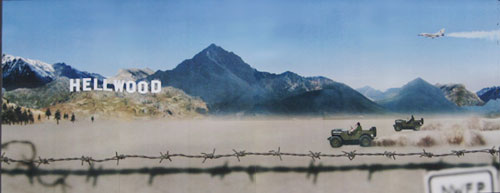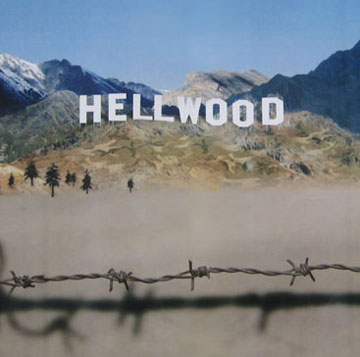Pakistan-Politics & Art
The Colors of Political Protest in Pakistan
What does it feel like to be a young adult in Pakistan? Is the country really the way the media presents it with themes of terrorism, religious extremism, oppression of women, or any other volatile topic that attracts attention? Some artwork from the Visual Communications students at Beaconhouse National University in Lahore tells a different story.
During my last week in Lahore, several design students submitted artwork that reflected their experiences about the current state of affairs in their homeland. The following two pieces are examples of the art and messages they conveyed.
A Map of Pakistan
by Alwina and Amna
This large map of Pakistan (8 x 3 feet / 2.5 x 1 meters) was a floor sculpture. It was covered with green hands, reaching upwards. (The color of the flag of Pakistan is green.) The piece is a true testimony to the search for peace and stability in Pakistan.

(Full-scale)

This turned out to be a very timely piece because on March 16, 2009, after several weeks of political protests and strikes (not unlike those of the Vietnam era in the US), the Chief Justice of the Supreme Court was reinstated. (As a friend explained, “The Supreme Court is *our* symbol of the top institution. Restoring him sends a message to those who removed him not to mess around with *our* institutions.) Hopefully, this is a turning point. Pakistan has the potential to be a democracy that inspires other countries in the region.
Hellwood
by Ali (Happy) and Janaka
Another compelling political statement was a photographic image of the North-West Frontier Province (NWFP) that American drones are bombing. “Hellwood” (in bold white letters evocative of the world famous "Hollywood Sign”) was placed on top of the camouflage-colored mountains. Ali Haider passed away in 2010 but his spirit and art work lives on. His ancestors were from Afghanistan. He created the piece in collaboration with Janaka, an exchange student from Sri Lanka. This image presents another view – that of the tragedy of daily life - in this region . Although there may be pockets of militancy and religious extremism in the remote tribal areas, there are 21,000,000 people (none of whom have connection to terrorists) who are simply struggling to survive in this mountainous area, appropriately labeled “Hellwood.”

Detail


Ali explained the piece:
"My forefathers are from Afghanistan so that’s why I care for Afghanistan people. I never went to the NWFP but I have the relation of brotherhood because they are Muslims. I want help these people because they are helpless now a days. NFWP people get murdered without reason. Being a visual communication designer I want to do something for them and that situation. "
About the NWFP: The North-West Frontier Province stretches from the Himalayas in the north to the deserts in the south where it is bordered by the Baluchistan and Punjab provinces. On its western flank is the rugged terrain of neighboring country Afghanistan, which is accessed via the historic Khyber Pass through the mountains. Click here for more information and a map.
Consider this: A growing feeling among Muslims that they are under attack from the West could be a major contributory factor behind the growing insurgency in the region.
In conclusion, perhaps these students have succeeded in presenting the colors of the peace we all seek.


